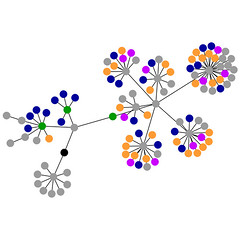 Over my winter holidays I spent some time on learning how to manage my systems with puppet, the next generation configuration management system.
Over my winter holidays I spent some time on learning how to manage my systems with puppet, the next generation configuration management system.
This handy piece of software is written in ruby and provides it's own ruby-like scripting language to define configurations for hosts. It currently manages all my cluster nodes and all my desktop and server systems.
The so called manifests that are now used to provide uniform configuration for all those systems at Fladi.at can be found on my Subversion repository. I will enhance those manifests in the next weeks to also include Apache virtual host configurations and Subversion repository management.
So far, only the basic system level configuration is managed by puppet at Fladi.at (SSO, logging, LDAP-Avatars for GDM, Udev and permissions for Nvidia device nodes, ...). Puppet provides a solution to almost every aspect of an unix-style OS to be managed by a centralized instance but it requires a lot of knowledge on its scripting features which I'm currently lacking. Just keep visiting this blog to stay informed on further major additions to the subversion repository.
To use puppet on a Debian system just install the appropriate package and make sure that the "puppet" hostname in your DNS search scope (see /etc/resolv.conf) points to a server running the puppetmaster daemon. In case of Fladi.at it's puppet.fladi.at which serves all the configuration directives to the local puppet instance.
aptitude install puppet
This will pull in some dependencies like ruby and facter. A good starting point for setting up your own puppetmaster server is the "Getting Started Recipe".
For the Debian package it is possible to set the name of the server puppet will pull get it's configuration from in /etc/puppet/puppet.conf:
[main] server=puppet.example.com
To pull my configuration for Fladi.at into a puppetmaster for further modification just make sure that a Subversion client is installed and run:
svn co http://subversion.fladi.at/sso/ /etc/puppet/ ln -s /etc/puppet/templates/* /var/lib/puppet/templates/
Now just start the puppetmaster and test if your clients are getting their configuration.
 After watching the recording of the Wikileaks lecture on the 25c3 I decided to support them by starting a Tor exit node on uni.fladi.at and thereby donate them some bandwidth.
After watching the recording of the Wikileaks lecture on the 25c3 I decided to support them by starting a Tor exit node on uni.fladi.at and thereby donate them some bandwidth.
The configuration necessary to run such a node can be found at my Wiki. I hope that this will help others to set up more nodes and make the Tor network more reliable for anonymous sources to use.
It's not that much as I expected but finally there was some slight snowfall in Graz. The depressing gray is gone and has been replaced by a glittering white blanket.
 I can't believe it: Debian can be installed on the new Android G1 without loosing the original functionality!
In the video you can see them install the "openssh-server" package from gtp.de.debian.org. This is fairly easy because Debian already supports the underlying ARM EABI provided by the CPU of the Android G1.
I can't believe it: Debian can be installed on the new Android G1 without loosing the original functionality!
In the video you can see them install the "openssh-server" package from gtp.de.debian.org. This is fairly easy because Debian already supports the underlying ARM EABI provided by the CPU of the Android G1.
I NEED THIS GADGET RIGHT NOW!!!!! 
 Approximately one month ago the TWiki project was forked due to bad blood between the community developers and the project management, triggered by trademark issues over TWiki.net. The now newly forked project was named NextWiki at first and now became Foswiki which has been released as version 1.0.0 a few weeks ago.
Approximately one month ago the TWiki project was forked due to bad blood between the community developers and the project management, triggered by trademark issues over TWiki.net. The now newly forked project was named NextWiki at first and now became Foswiki which has been released as version 1.0.0 a few weeks ago.
As I was running a TWiki installation on the domain wiki.fladi.at I was really eager to merge this one to the new Foswiki because I think it will evolve faster and in a better direction with most of the community developers now working on it.The merge itself was fairly easy: I did a complete backup of my TWiki installation and then cleared the whole wiki.fladi.at virtual host from the Apache configuration and deployed a clean new Installation of Foswiki to this domain.
Installation of my plugins and extensions is now even easier than before because it can now be accomplished directly from within the configure script. After I had all my required plugins in place, I copied all the old Webs from my TWiki backup into the new Foswiki installation and they showed up without trouble.
Besides from some yet unsolved problems with LaTeX and some URF-8 conversions issues I quite happy with the first reelase of Foswiki. It is really worth the effort to do the switch from the old TWiki software.
 Today there was a planned (and announced) outage on the power supply for the network infrastructure on the Medical University Graz. This has also affected the connectivity of uni.fladi.at.
Today there was a planned (and announced) outage on the power supply for the network infrastructure on the Medical University Graz. This has also affected the connectivity of uni.fladi.at.
The server was not reachable due to the lack of network connectivity for almost 6 hours. Now it's back up and running.
I hope that I will not forget to publish such outages on this blog for the next time.
 For the last month I was tinkering around with the latest release of Eclipse, Ganymede, in order to use it as my primary development tool. The operation system used was as always Debian/unstable on amd64 architecture. But at first it didn't look that promising to me: A lot of crashes and troubles paved the way while I was eagerly enhancing it with all the plugins I needed. On some occasions I wasn't even able to open a single file in the IDE.
For the last month I was tinkering around with the latest release of Eclipse, Ganymede, in order to use it as my primary development tool. The operation system used was as always Debian/unstable on amd64 architecture. But at first it didn't look that promising to me: A lot of crashes and troubles paved the way while I was eagerly enhancing it with all the plugins I needed. On some occasions I wasn't even able to open a single file in the IDE.
Most of those crashes were segmentation faults (SIGSEGV) located somewhere in the JVM or in some external libaries (libgcrypt.so for example).
Time has passed since then and now it seems that my configuration of Eclipse Ganymede is finally stable and useable. The whole configuration, which consists mostly of options for the vmargs command line switch can be found in my Wiki at the EclipseSettings topic. An excerpt of the plugins I am using can also be found there.
 I think I found the perfect car for me: The TH!NK Ox
I think I found the perfect car for me: The TH!NK Ox
On their webpage, the creator promises that this car will provide open source interfaces but does not yet reveal what can be controlled by them.
TH!NK, a company based in norway, has announced to build this car in 2011. In times where humanity has to relize that fossil fuel will not last forever it would be nice to call such a car yours.
Let's see what happens in 2011  On my part I'll put some money aside in case my current car breaks somewhere around the time the TH!NK Ox becomes avialable to the public.
On my part I'll put some money aside in case my current car breaks somewhere around the time the TH!NK Ox becomes avialable to the public.
 Yesterday I got the WWAN module for my HP 8530w notebook. As I'm running only Linux on this system I was curious if it would work out of the box for GNU/Debian/unstable/amd64.
Yesterday I got the WWAN module for my HP 8530w notebook. As I'm running only Linux on this system I was curious if it would work out of the box for GNU/Debian/unstable/amd64.
The installation of the Hardware was easy, the box even included a small but handy screwdriver to open the cover on the bottom of the notebook.
Entering the BIOS and searching through the system information is found the module recognized and enabled. The frustration started when I booted Linux and found no trace of the device in the upper level system management tools.
A quick lsusb revealed that the kernel is at least aware of my module but it seems that no kernel-module feels of being in charge of this piece of hardware. After some investigation in the shipped manual I came up with two possible namings for the chip: "HP un2400" and "UNDP-1". The later seems to be manufactured by Qualcomm but even an extensive search on Google just brought me to a post in an Ubuntu related forum but with no working solution.
Seems like I have to wait for someone with better technical skill to enhance the existing kernel-modules (maybe usbserial.c and option.c?) and have a working WWAN on my notebook.
Here are some photos i took while putting the hardware in place.
[gallery link="file"]
During the last two weeks a new UPS was deployed to our main server room here at the "Vorklinik" basement.
It now supplies our various network and server hardware with 60 kVA of power in case of an outage in the main power grid. Running just the absolutely necessary systems (ie. without redundancy systems online) this keep our infrastructure up and running for about 60 minutes.
It a later stage of extension a current generator will be connected to the new UPS to take over the power consumption load and extend the period of autarky.
[gallery link="file"]
 A small stepp further on my way to make my ned WWAN module work with Debian/amd64. Another post on the Ubuntu forums pointed me towards a kernel module named "hp-wmi" which, when loaded, will at least make the device appear in
A small stepp further on my way to make my ned WWAN module work with Debian/amd64. Another post on the Ubuntu forums pointed me towards a kernel module named "hp-wmi" which, when loaded, will at least make the device appear in lsusb. This module is available in kernel 2.6.27 or later so I had to build my own custom kernel from 2.6.28.1 with this module enabled.
I'll provide a short guide on how to at least enable the hardware. So far the modem or GPS functionallity is not usable but I'll post updates as soon as I see any progress.
root@corellia { ~ }$ cd /usr/src root@corellia { /usr/src }$ wget http://www.kernel.org/pub/linux/kernel/v2.6/linux-2.6.28.1.tar.bz2 root@corellia { /usr/src }$ tar xfj linux-2.6.28.1.tar.bz2 root@corellia { /usr/src }$ cd linux-2.6.28.1 root@corellia { /usr/src/linux-2.6.28.1 }$ make menuconfig
Now enable the module: Device Drivers --> Misc devices --> HP WMI extras The "corellia2" revision is the hostname "corellia" of my laptop for which I'm building this custom kernel and "2" is the version of the custom kernel. I already had a custom 2.6.27.9 with the revision "corellia1" deployed on this machine. You can choose your own revision or ommit it by removing the appropriate switch from the line.
root@corellia { /usr/src/linux-2.6.28.1 }$ make-kpkg --arch amd64 --initrd --revision corellia2 buildpackage root@corellia { /usr/src/linux-2.6.28.1 }$ cd .. root@corellia { /usr/src }$ dpkg -i linux-image-2.6.28.1_corellia2_amd64.deb
Now reboot into the new kernel and check if everything still works. After that, continue by loading the hp-wmi module.
root@corellia { ~ }$ modinfo hp-wmi filename: /lib/modules/2.6.28.1/kernel/drivers/misc/hp-wmi.ko alias: wmi:5FB7F034-2C63-45e9-BE91-3D44E2C707E4 alias: wmi:95F24279-4D7B-4334-9387-ACCDC67EF61C license: GPL description: HP laptop WMI hotkeys driver author: Matthew Garrett <mjg59@srcf.ucam.org> depends: rfkill,wmi vermagic: 2.6.28.1 SMP mod_unload modversions root@corellia { ~ }$ modprobe hp-wmi root@corellia { ~ }$ lsusb | grep 03f0:201d Bus 007 Device 003: ID 03f0:201d Hewlett-Packard
Now the device is visible at last. It seems that there is not much left to do to access the modem and GPS module .... At least I hope so.
 When was the last time you had a clear good view of the milkyway in all its sky filling beauty?
When was the last time you had a clear good view of the milkyway in all its sky filling beauty?
You don't remember? Or worse, you can't even see most of the stars above us because of all the light around you even in the middle of the night?
I grew up in a relatively small town at the edge of the Alps and so it was nothing special to me to watch the milkyway, the small meteors and the constellations on a clear night while walking home from bars. As I lately moved into a bigger town, Graz, i noticed the bright dome of light it emits into the sky every night and which is visible from far away.
This light, emitted by the lanterns, the illuminated advertising panels, and through the windows of our homes, outshines the weak but fascinating spectacle above out heads: the night sky.
Earth Hour strives to bring back this beauty to all of us, even if it's only for a short time, by turning off our lights for just a brief moment. Their call goes out to each and every person by himself but even whole cities are asked to join in and dim down their lights for the given date and time. Read what they have to say on their website and I would be glad if you'd come to join them on 8:30PM Saturday 28 March 2009 by turning off your lights for one hour.
If you can, use this hour to grab a binocular or telescope (and for some special moments, your loved one or your friends) and go outside and watch the stars. Hope you enjoy it as much as I will 
Time till Earth Hour begins:
The first one of our three new 19" server racks has been installed. When everything is in place these new racks will be filled with hosts for our VMware cluster.
I hope it does not get clogged up too soon because we are already at the maximum racks that can fit into this room.
[gallery link="file"]
In the aftermath of the recent announcement of some additional CSS2.1 test passed by IE 8 RC1 I got curious if this latest version of their soon-to-be-released browser is finally able to render SVG graphics (at least they got the PNG alpha channel right in IE7). A vanilla installation of Windows 7 Public Beta provided a good opportunity to try some SVG tests online. There was especially one test that did show my mood on the results very clear:
This site should show a green smiley if SVG can be rendered correctly and which overlays a red one, which is only visible when the browser is incapable of SVG.
It turned out that Microsoft didn't even try to implement it but rather leave it up to thrid party developers to write SVG rendering addons for IE8.
Firefox passed the same test without any complaints!
Found this one while browsing the web. It's old but i have not seen it before and it gave me the typical what-the-fuck-is-wrong-with-Microsoft look on my face 
A great, mind boggling knowledge article directly from the bowls of redmond: http://support.microsoft.com/default.aspx?scid=kb;en;276304
 Following the recent announcement of the child database in UK a lot of discussion has spawned here in Austria and Germany on how long it will take the ones responsible for this system to lose all their data.
Following the recent announcement of the child database in UK a lot of discussion has spawned here in Austria and Germany on how long it will take the ones responsible for this system to lose all their data.
The UK has become quite popular for forgetting USB-sticks with government data inside cabins or to sell unformatted hard-drives on Ebay. Their latest creation, the child protection database, will be a bit too large to fit on a single USB-stick so it is quite obvious that it has to be "forgotten" on one of this fancy new 1,5TB (or even 2TB, they are about to hit the market soon) hard-drives. Bets are still accepted on the manufacturer or the place where it will be found.
Another interesting fact about this database is the lack of data on childs from politicians and celebs. It seem to me that those childs are not worth being "protected". Or did somebody responsible for this database learn at least a little bit from the past british databases, lost all over their country?
I hope that our government here in Austria does not accidentially stumble across this idea. I'll really do my best to oppose such a development!
Today I tried to view a video on YouTube. The URL to it was mentioned on a Linux related IRC channel. After opening the Link inside my Browser here at the Campus02 in Graz I was confronted with the error that this video is not available in my country (presumably Austria, but it's not mentioned anywhere). This leads me to the conclusion that the Internet is starting to become more national after being the biggest international medium. Some years ago it did not matter from which country you were connected to the net. Maybe I'll try the Tor network to circumvent such measures. It's sad to see where all this is heading to.


